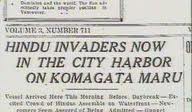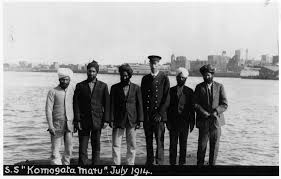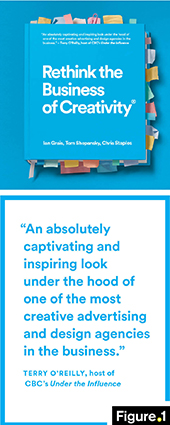Endless Eye in nation’s capital
In synch with an apology by Prime Minister Trudeau--on May 18th--Ekstasis Editions has released a new book on the Komagata Maru incident.
May 16th, 2016
The B.C. government already apologized for the Komagara Maru Incident. Now it's Ottawa's turn.
A Journey With the Endless Eye recalls events of 1914 when some 376 Indian migrants were refused entry in Vancouver harbour.
With text by Ajmer Rode and paintings by Jarnail Singh, A Journey With the Endless Eye: Stories of the Komagata Maru Incident (Ekstasis Editions $34.95) includes paintings by Jarnail Singh newly on display at Carleton University in Ottawa.
The permanent exhibition of ten Komagata Maru paintings by Indo-Canadian painter Jarnail Singh was opened by Carleton University President Dr. Roseann Runte at 4 pm on 18 May, 2016, the day the Honorable Prime Minister Justin Trudeau offered his Komagata Maru apology in the House of Commons.
“We laud Carleton University and Barj Dhahan, a founding donor and board member of Canada India Centre for Excellence at Carleton,” said Victoria publisher Richard Olafson, “for rendering this exemplary service to our community and country.”
The Komagata Maru steamship with 376 Indian passengers arrived in Vancouver on 23 May 1914. Many of the passengers were ex-military men who had made sacrifices for the British empire in wars. Even though passengers had British passports, Canadian Immigration officials essentially imprisoned them in their own ship, with insufficient water and food, eventually forcing them back to India after two months in the harbour.
 The ship had been chartered for $66,000 by Gurdit Singh Sarhali, a Sikh entrepreneur, as a direct challenge to a restrictive “continuous journey” policy that required all would-be immigrants from India to take direct passage to Canada—when no such direct passage from India existed.
The ship had been chartered for $66,000 by Gurdit Singh Sarhali, a Sikh entrepreneur, as a direct challenge to a restrictive “continuous journey” policy that required all would-be immigrants from India to take direct passage to Canada—when no such direct passage from India existed.
(In 1908, Canada had passed a law that allowed government officials to prevent immigrants who had not travelled by “continuous journey” from their country of origin. It was known that the distance from India to Canada necessitated stopovers along the way.)
“What is done with a shipload of my people will determine whether we shall have peace in all parts of the empire,” said Gurdit Singh in May of 1914.
An attempt to board the ship by 150 armed men, in support of a Canadian immigration official, was rebuffed. It took the arrival of the federal navy vessel H.M.C.S. Rainbow on July 23, 1914, to force the Komagata Maru to leave the city and return to Calcutta.
 The would-be Candians were mostly forced back to the Indian port of Budge Budge Ghat, near Calcutta, where British-India police fired on them, killing 19 people and injuring many more.
The would-be Candians were mostly forced back to the Indian port of Budge Budge Ghat, near Calcutta, where British-India police fired on them, killing 19 people and injuring many more.
The voyage of the Komagata Maru can now be viewed as a brave but ill-fated attempt to confront the racism of Canada’s immigrations laws. It has been the subject of numerous books in the last several decades.
The Komagata Maru stand-off has been most extensively documented and examined by Hugh Johnston in The Voyage of the Komagata Maru: The Sikh Challenge to Canada’s Colour Bar, first issued in 1979, reprinted in 1989, and soon to re-issued in April of 2014 in an expanded version. With Tara Singh Bains, Hugh Johnston also published The Four Quarters of the Night: The Life-Journey of an Emigrant Sikh (1995) and Jewels of the Qila: The Remarkable Story of an Indo-Canadian Family (2012).
Jarnail Singh is an artist, illustrator, designer, photographer, and art journalist. He resides in Surrey, British Columbia since immigrating to Canada in 2000. Born in Punjab, India, he received a Bachelor of Arts degree from the Punjab University, Chandigarh. He was mentored by his father Kirpal Singh, an outstanding Sikh artist, from whom he inherited not only the painting talent but also the appreciation of historical icons and their role in the history of Sikhism. He continues the tradition of portraying Sikh Gurus and historical events. As well he has done much to capture the images of Punjabi folklore disappearing fast.
Jarnail Singh has exhibited his art at numerous national and international venues; his works are included in Central Sikh Museum, the Golden Temple, Amritsar, and several other important collections. The city of Surrey honored Jarnail Singh with the First Civic Treasures Award; he is among the twelve persons from art, literature and culture honored for their lifetime contributions to the city’s art scene.
“Painting for me is a process of infinite happiness and joy,” says Singh. “Many a time people ask me, what do you paint, and I reply, I paint everything, people, portraits, landscapes, anything that touches me, inspires me.”
Ajmer Rode has published books of poetry, drama, prose and translation in Punjabi and English. Ajmer is considered founder of Canadian Punjabi drama and his full length play Komagata Maru was recently digitized and published on-line by Canada’s Simon Fraser University.
**
Alan Dutton, Robert Jarvis, Sohan Sarinder Singh Sangha, Ajmer Rode and Kesar Singh have also written other books on the Komagata Maru incident after Sharon Pollock led the way in 1976 with a play about the racist stand-off.
In 1990, the Progressive Indo-Canadian Community Services Society also published the proceedings of a Vancouver conference, Beyond the Komagata Maru: Race Relations Today, edited by Alan Dutton.
Kamala Elizabeth Nayar of Surrey first conducted more than one hundred interviews for The Sikh Diaspora in Vancouver: Three Generations Amid Tradition, Modernity and Multiculturalism (UTP 2004) which examines family relations, child-rearing and religion. She has conducted another one hundred interviews for The Punjabis in British Columbia: Location, Labour, First Nations and Multiculturalism (McGill-Queens $32.95) with a particular emphasis on the relocation of Punjabis from the Skeena region to B.C.’s Lower Mainland during the decline of the forestry and fishing industries. Nayar teaches Asian Studies at Kwantlen Polytechnic University.
Growing up in Vancouver, Phinder Dulai had pondered the Komagata Maru story since his Vancouver college days in the late 1980s. He first wrote about it on the 80th anniversary of the stand-off in 1994 in the form of a fictionalized letter to one of the passengers on the ship. Eventually he published a book of “hybrid poetics” that mixes historical fact with fiction for dream / arteries (Talonbooks 2014).
978-1-77171-078-7




Leave a Reply